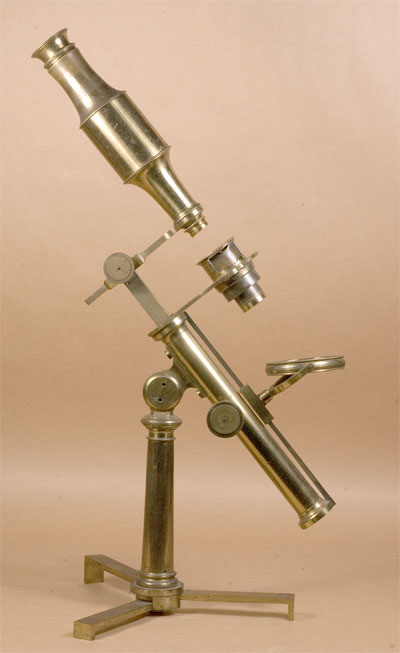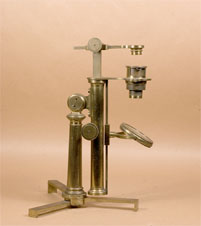 |
|||||
 |
 |
||||
 |
|||||
 |
 |
||||
Compound Microscope made by George Adams, Jr. (No. 6) |
|||||||||||||
 |
Age: c1785 Made by: George Adams, Jr. Made in: England |
||||||||||||
 |
|||||||||||||
|
G. Adams, N°. 60 Fleet Street, London
|
|||||||||||||
 |
|||||||||||||
|
Adams' universal microscope used as a simple magnifier.
|
|||||||||||||
|
This all-brass monocular was made by the son of George Adams, Sr. (1704–1773), a self-taught artisan in London, who established his shop on Fleet Street at the sign of Tycho Brahe's Head. Over a number of decades George Adams and Son produced quality instruments, including microscopes, as well as a number of books on microscopy. In 1746 he published the first of four editions of his book Micrographia Illustrata, a popular work which showcased the new models of his own production. He also included descriptions of methods for measuring the magnifying power of his microscopes. Adams Senior made several instruments for King George III, including an instrument called "The Prince of Wales microscope" (sometime between 1751 and 1760) and the famous ornate Silver Microscope created in 1761. When George senior died, his son (also George Adams, 1750–1795) took on the family business. George Jr. continued to make instruments, and improve microscopes. He was a more prolific writer than his father and produced a large number of works regarding instrumentation, including a series called Essays on the Microscope (1787). After George Jr. died his younger brother Dudley Adams continued the firm at 60 Fleet Street until the 1830s. In Essays on the Microscope George Adams Jr. included a description of an "Improved Compound Microscope" that is an updated version of George Senior's "New Universal Double Microscope" described in Illustrata. Both are similar to this instrument in the Golub Collection. The Adams instrument displayed here is approximately 40cm tall and stands on a folding tripod base. The main supporting pillar attaches by a compass joint at the top to a cylindrical tube, which contains a rack and pinion as the focusing mechanism. The body tube is attached to a cantilevered support that is screwed to the top of a solid square rod. It has a rack and pinion mechanism for the forward-backward movement of the microscope for sample scanning. The microscope has typical optics (eyepiece, field, and objective lenses). However, the eyepiece consists of two biconvex lenses. The objective lens is engraved "7" and is a very low magnification with long focal length. It is possible that it was intended to be used as a single magnifier much like Adams' "New Universal Single Microscope". The stage has arm extensions with slots for accessories, such as a fish-plate, bull's eye lens or tweezers. It also has a fitted Bonanni spring stage with a condenser lens at its base. The stage is engraved "G. Adams N° 60 Fleet Street, London." The mirror attaches to a rectangular rod screwed on the front of the cylindrical tube and moves vertically, using friction as a stop. Included with this instrument is a an ivory sample slide. |
|||||||||||||
| Featured 12/2007 | |||||||||||||